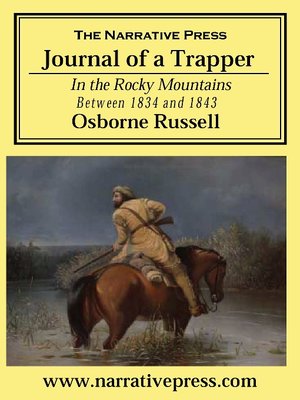
Sign up to save your library
With an OverDrive account, you can save your favorite libraries for at-a-glance information about availability. Find out more about OverDrive accounts.
Find this title in Libby, the library reading app by OverDrive.



Search for a digital library with this title
Title found at these libraries:
| Library Name | Distance |
|---|---|
| Loading... |
Ever wonder how everyone made it west? They used trails beaten out by such men as Osborne Russell. He wrote this book partially to refute The Personal Narrative of James O. Pattie (one of our favorite books) which he claimed contained many inaccuracies. Russell included only information he considered "proved true by experience."
Written in an intensely personal style that lacks punctuation at times, The Journal of a Trapper abounds in details about hunting and trapping in the Rockies, including descriptions of the particulars of the animals he encountered. He travelled along the Yellowstone, Snake, and Sweetwater rivers (among others), through the Rockies and Tetons. His book is so accurate that recent readers have retraced his steps using it.
Russell encountered numerous Indian tribes, and takes care to portray them accurately: the Snake or "Sho-sho-nie" Indians are "kind and hospitable to whites thankful for favors indignant at injuries" while "if a Crow husband wishes to speak to his mother-in-law, he speaks to the wife who conveys it to the mother...a custom peculiar to the Crows."
Of course, not all his encounters are friendly, and while camping along the Yellowstone river in Blackfoot country, Russell is keeping watch:
"I arose and kindled a fire filled my tobacco pipe and sat down to smoke My comrade whose name was White was still sleeping. Presently I cast my eyes towards the horses which were feeding in the Valley and discovered the heads of some Indians who were gliding round under the bench within 80 steps of me I jumped to my rifle and aroused White and looking towards my powder horn and bullet pouch it was already in the hands of an Indian and we were completely surrounded We cocked our rifles and started thro. their ranks into the woods which seemed to be completely filled with Blackfeet who rent the air with their horrid yells, on presenting our rifles they opened a space about 20 ft. wide thro. which we plunged about the fourth jump an arrow struck White on the right hip joint I hastily told him to pull it out and I spoke another arrow struck me in the same place but they did not retard our progress At length another arrow striking thro. my right leg above the knee benumbed the flesh so that I fell with my breast accross a log. The Indian who shot me was within 8 ft and made a Spring towards me with his uplifted battle axe: I made a leap and avoided the blow and kept hopping from log to log thro. a shower of arrows which flew around us like hail, lodging in the pines and logs..."
(Out of breath yet?) Russell's journal reflects the complex character of many of the independent men of that era; adventurous, tough, and resourceful. He was a politician in Oregon when he decided to write about his earlier life as a trapper in the Rocky Mountains, and he retained the authentic "voice of the west" -- Read it for its exact yet colorful descriptions, and for a rollicking good time.







